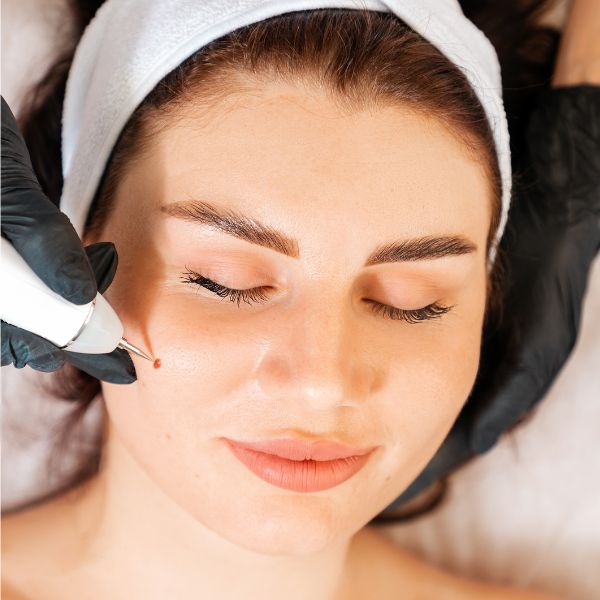
Introduction
A mole is one of the skin growths that occurs on the skin. It is also known as a nevi. It often appears as small, dark brown spots and is caused by clusters of pigment-forming cells. It is common for people to have between 10 and 40 moles during their childhood and adolescence, and they may change in appearance or fade over time.
The majority of moles are harmless. There are very few cases of moles that become cancerous. You should be aware of changes in your moles and other pigmented patches in order to detect skin cancer, particularly malignant melanoma.
Types of Moles.
There are many types of moles which are based on their characteristics, appearance, and how they develop. Here are some common types of moles:
Common Moles (Nevus Spilus): The most typical moles are called common moles, and they may appear anywhere on the body. They typically range in size from small to circular and their uniform color ranges from light tan to dark brown. Most common moles are benign.
Atypical Moles (Dysplastic Nevi): Atypical moles are larger, formed differently, and colored differently from common moles. They could have a light border and a dark brown core. Since these moles are thought to be more likely to progress to melanoma (skin cancer), regular dermatologist monitoring is crucial.
Congenital Moles: congenital moles are birthmarks. Their size and color can vary. Larger congenital moles should be followed by a dermatologist since they have a slightly increased chance of turning into melanoma.
Acquired Moles: Acquired Moles are the most frequent type of moles that are acquired ones, which appear after birth. They can appear at any age and over time, they can change size, shape, or color. Generally, new moles are benign.
Junctional Moles: the junctional moles have a flat appearance and are usually brown. They are located at the junction of the epidermis (outer layer of skin) and the dermis (deeper layer of skin).
Intradermal Moles: intradermal moles are typically flesh-colored, increased, or just a little pink. They typically appear in maturity and may gradually lose their coloration.
Blue Moles: Blue nevi, often known as blue moles. These are typically black or dark blue in color. They can be seen anywhere on the body and are more common in older people.
Halo Moles: Halo moles are characterized by a pale, white halo surrounding the mole. As a result of the body’s immune system attacking the melanocytes within the mole, this halo appears.
Spitz Moles: Spitz moles are often raised, red, or pink and can resemble melanoma. This condition is more common among children and adolescents, but it can also be encountered in adults. It is important to consult a dermatologist if you have spitz moles so that any cancerous changes can be ruled out.
Mongolian Spots: Mongolian Spots are a form of birthmark rather than real moles. They are usually blue-gray in color and frequently develop on the lower back or buttocks. People with darker skin seem to have them more commonly.

Mole removal treatment guidelines.
It’s common for dermatologists to remove moles, but this procedure should be approached with caution to ensure your safety. Here are some common pointers and actions to take into account when getting mole removal treatment.
-
- The first and most important step is to schedule a consultation with your trusted dermatologist. Your dermatologist will also consult the different ways of mole removal choices which are based on the size, location, and medical background of the mole.
-
- Discuss with your doctor about any allergies, medical conditions, or medication that you are taking. This information is important to make sure the safety process.
-
- Tell your expectations for the mole removal in detail and freely with the dermatologist. With this information, doctors can adjust the process according to your cosmetic objectives.
-
- Your dermatologist may recommend one of the mole removal methods like excision surgery, shave excision, laser removal, or cryotherapy. They will explain the advantages and disadvantages of each method.
-
- Mole removal procedures typically exist in dermatologist clinics. Your doctor will use the local anesthesia to reduce the pain.
-
- Follow the instructions of your dermatologist’s post-procedure care to promote proper healing and minimize the risk if infection or scarring.
-
- Apply any prescribed ointments or dressing as directed. Avoid sunlight on the treated area.
-
- Make sure you attend all scheduled appointments with your doctor to observe the healing process and report any sign of infection, excessive bleeding, severe pain, or any unusual changes in the treated area.
-
- If you are concerned about scaring then discuss it with your doctor. They may recommend treatments like silicone gel sheets or laser therapy.
-
- Regularly examine your skin and schedule periodic skin checkups to monitor any new moles or changes in existing ones.
Can a mole be removed without surgery?
Yes, moles can be removed without surgery through various non-surgical methods like laser removal, cryotherapy (freezing), electrocautery (burning), chemical peels, and shave excision. The choice of method depends on factors like the type, size, and location of the mole. It’s important to consult with your doctor to discover the most suitable and safe removal approach for your specific situation.
It is important to differentiate between harmless and potentially cancerous moles. The size, shape, color, or texture of a mole that displays cancerous characteristics should not be removed without being thoroughly examined by a healthcare provider. It may be necessary to perform a biopsy in such circumstances to determine whether the mole is precancerous or cancerous.
It is typically a medical necessity to remove a cancerous mole in order to prevent the spread of cancer.
Is Mole Removal Treatment At Home Safe?
It is possible to safely remove moles at home if they are treated cautiously and according to their type. Before attempting any DIY methods, it’s crucial to consult with a healthcare professional. It may be possible to treat certain moles with home remedies, such as using apple cider vinegar or garlic, but they can also carry risks, such as infection or scarring.
Not every mole is a good candidate for removal from the home, particularly if it shows signs of irregularity, imbalance, or changes in size, color, or shape. These should be examined by a medical professional since they might be signs of a potentially more serious problem such as skin cancer. Furthermore, self-treatment might be dangerous and less successful if the mole is situated in a delicate or challenging-to-access part of the face.
It’s important to approach mole removal with care and prioritize professional consultation to ensure the best possible outcome.
Can Removing A Mole Cause Cancer?
It is not possible to cause cancer by removing a benign (non-cancerous) mole. In fact, when moles exhibit suspicious characteristics or have the potential to become cancerous, removal is often recommended.
It’s important to differentiate between harmless and possibly dangerous moles. If a mole looks cancerous such as changes in size, shape, color, or texture, it should not be removed without a thorough evaluation by your doctor. In such cases, a biopsy may be required to detect whether the mole is cancerous.
It is usually a medical necessity to remove a cancerous mole to prevent the spread of the disease. Doctors or surgeons usually perform this procedure to treat skin cancer. Cancerous moles are not the cause of cancer; they are simply a necessary part of treating and managing it.
Removing benign moles is safe and does not cause cancer. It is important to have any unsure or changing moles increased by the doctor to exclude skin cancer and control the most suitable course of action. A satisfactory outcome for skin cancer requires early identification and treatment It is generally performed by a doctor or a surgeon as part of skin cancer treatment. Removing a malignant mole is an important part of treating and managing the disease. It is not the cause of cancer.
Conclusion
To conclude, mole removal is a complex process and requires careful consideration as well as professional guidance to achieve lasting results. Having a dermatologist determine the best course of action for your specific situation is essential to your health. Make sure your choices are aligned with your overall well-being when removing moles, as they are a natural part of who you are.
